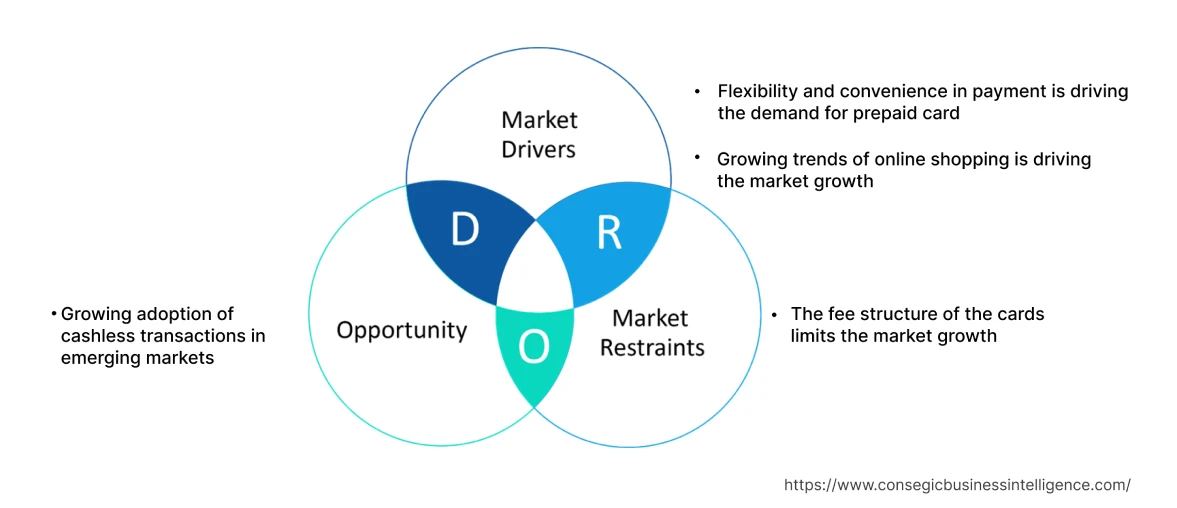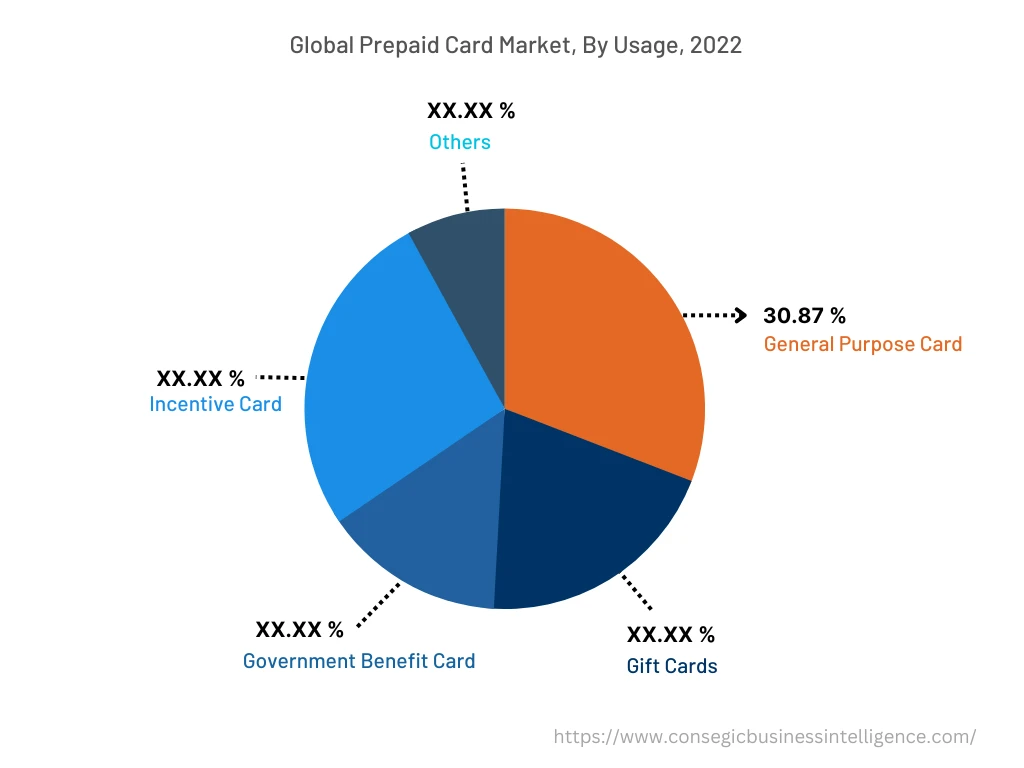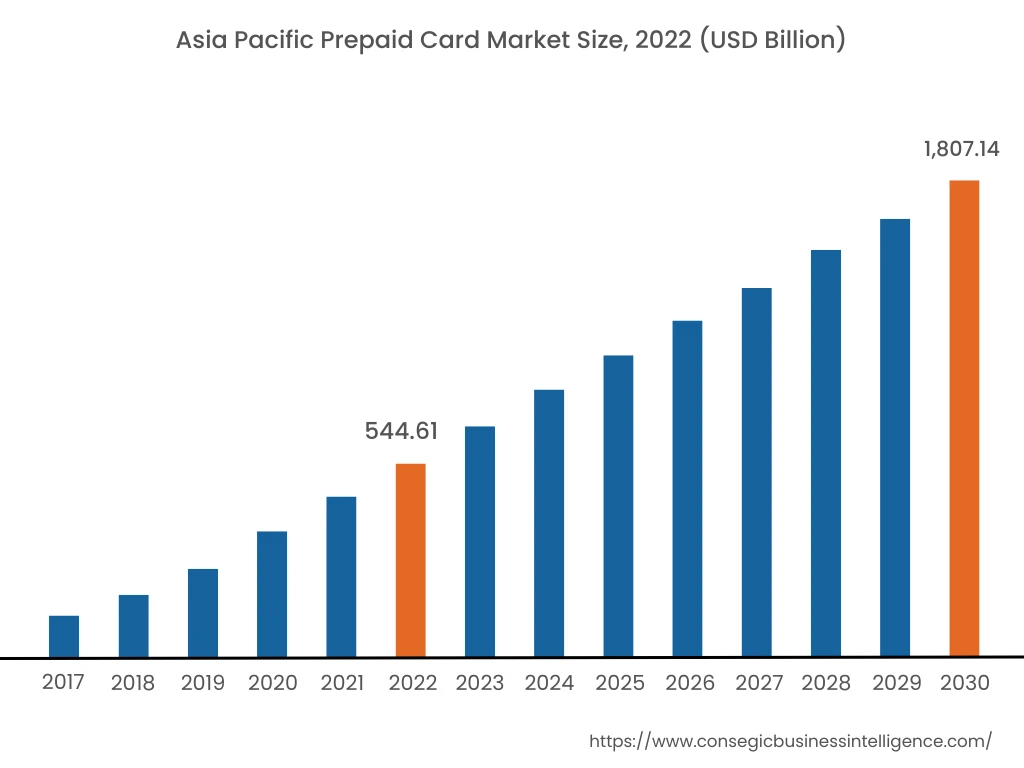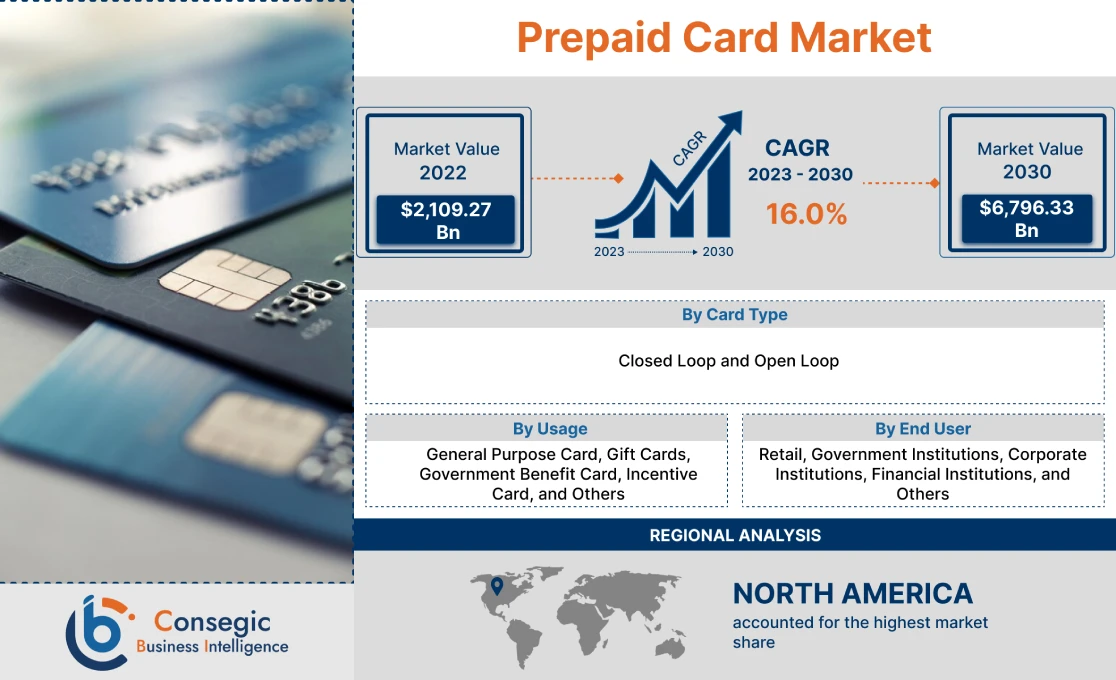Prepaid Card Market Size :
Prepaid Card Market size is estimated to reach over USD 6,796.33 Billion by 2030 from a value of USD 2,109.27 Billion in 2022, growing at a CAGR of 16.0% from 2023 to 2030.
Prepaid Card Market Scope & Overview:
Prepaid Card also known as stored-value-card are payment cards that are preloaded with a specific amount of money. The cards are used for making various financial transactions including making online or in-store purchases, withdrawing cash from ATMs and paying bills among others. Further, as per the analysis, a wide range of cards are issued including heath saving account card, gifts card, government benefit card, travel card and incentives card amigo others.
Prepaid Card Market Insights :
Prepaid Card Market Dynamics - (DRO) :

Key Drivers :
Flexibility and convenience in payment is driving the demand for prepaid card
The increasing requirement for these cards due to advantages including flexibility and convenience is driving the market expansion. The card provides users with a flexible payment solution that is used for a wide range of transactions including in-store purchases, online payment, and bill payments among others. The versatility of the card allows consumers to make payment securely depending on the individual needs and preferences. Additionally, based on the analysis, these cards are easy to obtain or purchase and instantly get activated. The user of the payment cards funds the card through various channels including direct deposit, bank transfer and cash that further helps in driving the market expansion. For instance, in April 2023 AeronPay launched the AeronPay Prepaid Card, in partnership with Yes Bank. The card is launched considering the growing requirement for cashless transactions in retail payments. Thus, advantages including flexibility and convenience play an important role in driving the prepaid card market growth.
Growing trends of online shopping is driving the market expansion
The increasing penetration of high-speed internet along with rising numbers of smartphone users is resulting in the trends of online shopping which in turn spurs the demand for these cards. The cards are used for making transactions on e-commerce websites and digital marketplaces without the need for disclosing any banking information. As per the analysis, the features are especially helpful for people who have no access to the conventional payment system including debit cards and credit cards. For instance, according to Statista, in 2021 approximately 2.14 billion people worldwide purchased goods online. Further, retail e-commerce sale was approximately USD 5.2 trillion and is expected to reach USD 8.1 trillion by 2026.
Additionally, the increasing demand for prepaid gift cards for online gifting is further driving the market demand. The prepaid gift cards provide the recipient with flexibility to choose the desire product or service that makes the card versatile and convenient gift choice.
Key Restraints :
The fee structure of the cards limits the market expansion
The fee structure of the card plays a significant role in limiting the market trends. The cards are levied with different types of fees including monthly fee, transaction fee, cash reload fee, inactivity fee, and card replacement fee among others. Further, the complex fees structure of the cards results in a negative perception of the card. As per the analysis, the affordability of the card is a major factor for consumers who are price sensitive and are seeking cost effective financial solutions. Furthermore, fee transparency is an important factor for consumers to understand the cost structure of the cards. The complex and hidden fees associated with the cards further results in limiting market demand.
Future Opportunities :
Growing adoption of cashless transactions in emerging markets
There is growing demand for cashless transaction in emerging markets including China, India, and Brazil among others. The emerging markets have a large population of unbanked or underbanked people that create trends and prepaid card market opportunities. The card acts as a convenient and accessible financial tool for the inclusion of individuals in a digital economy. For instance, according to a report by Nium Pte. Ltd., 70% of the population in the Latin American region have no access to the banking system. The unbanked sector of the region offers huge opportunities for the prepaid card market. Further, the adoption of cashless transaction allows unbanked individuals to receive payments, make purchases and access various financial services through these cards. Based on the analysis, the partnership is expected to put forth the cashless transaction in rural areas of India. Thus, the growing trend of cashless transactions in emerging markets offers lucrative opportunities for the prepaid card market.
Prepaid Card Market Report Insights :
| Report Attributes | Report Details |
| Study Timeline | 2017-2030 |
| Market Size in 2030 | USD 6,796.33 Million |
| CAGR (2023-2030) | 16.0% |
| By Card Type | Closed Loop and Open Loop |
| By Usage | General Purpose Card, Gift Cards, Government Benefit Card, Incentive Card, and Others |
| By End-User | Retail, Government Institutions, Corporate Institutions, Financial Institutions, and Others |
| By Region | Asia-Pacific, Europe, North America, Latin America, Middle East & Africa |
| Key Players | Mastercard, PayPal Holdings, Inc., Visa, American Express Company, JPMorgan Chase & Co., H&R Block Inc., Banco Bilbao Vizcaya Argentaria S.A, Brink's Incorporated, Green Dot Corporation, Netspend, Revolut |
| Geographies Covered | |
| North America | U.S. Canada Mexico |
| Europe | U.K. Germany France Spain Italy Russia Benelux Rest of Europe |
| APAC | China South Korea Japan India Australia ASEAN Rest of Asia-Pacific |
| Middle East and Africa | GCC Turkey South Africa Rest of MEA |
| LATAM | Brazil Argentina Chile Rest of LATAM |
| Report Coverage | Revenue Forecast, Competitive Landscape, Growth Factors, Restraint or Challenges, Opportunities, Environment & Regulatory Landscape, PESTLE Analysis, PORTER Analysis, Key Technology Landscape, Value Chain Analysis, Cost Analysis, and Regional Trends & Forecast |
Prepaid Card Market Segmental Analysis :
By Card Type :
Based on the Card Type, the market is bifurcated into closed loop and open loop. The open loop holds the largest market share and is expected to grow at a significant growth rate. The open-loop card offers users convenience & flexibility in making payments resulting in market expansion of the segment. Further, with the growing trend of online shopping, open loop card has become a popular as secure and convenient payment options. Additionally, the open loop card offers several advantages including wider acceptance, cash withdrawal from ATMs, and international transactions among others. For instance, in July 2021, Mastercard, Mumbai Metro and Axis Bank launched the "One Mumbai Metro Card' which is a open loop card for contactless transactions. Thus, considering the overall trends the open loop market is anticipated to grow during the forecast period.
By Usage :
Based on the usage, the market is separated into general purpose card, gift cards, government benefit card, incentive card, and others. The general-purpose card holds the largest market share and is expected to grow at a significant growth rate. The versatility of the general-purpose card plays a key role in the development of the market. The general-purpose card is used for various types of transactions including in-store purchases, bill payments, online shopping, and cash withdrawals among others. Additionally, the general-purpose card eliminates the need to carry cash or checks that further helps in driving the expansion of the market. Thus, versatility of the general-purpose card is expected to drive the prepaid card market trends during the forecast period.

By End-User :
Based on the end user, the market is separated into retail, government institutions, corporate institutions, financial institutions, and others. The retail segmented accounted for the largest share in prepaid card market in 2022 and is anticipated to grow at highest CAGR. In the retail sector prepaid cars are commonly used for gifting purposes. The cards offer the use flexibility and convenience to choose the desired product as per requirement. Further, as per the analysis, retailers often provide a range of prepaid gift cards allowing customers to select cards specific to a particular store or brand. For instance, in December 2020, PayNearby launched launch PayNearby Shopping Card to enable retail partners to derive maximum benefits through digital commerce. Additionally, retailers often use these cards as a promotional tool to attract customers which further helps in driving the expansion of the market. Retailers offer these cards as incentives for purchases or as loyalty rewards, which in turn helps in retaining the customers.
By Region :
The regional segment includes North America, Europe, Asia Pacific, Middle East and Africa, and Latin America.

North America accounted for the largest revenue share in the year 2022. The growth is attributed to the increased adoption of technology which in turn leads to the increased demand for cashless payment solutions. Based on the prepaid card market analysis, these cards offer a secure and convenient alternative to the users for making cashless transactions. The card eliminates the need for carrying physical currency providing customers with a safer way to make purchases. In addition, the growth of the e-commerce industry in the region has resulted in significant growth of the prepaid card market. These cards ensure a secure online transaction through various e-commerce platforms without the need for conventional debit cards and credit cards. For instance, Netspend Corporation offers reloadable cards that offers convenience and control in making payments. The card also has several features including payback rewards and anytime alerts. Thus, owing to the above-mentioned factors, there is an increase in prepaid card market demand is expected to grow.
Asia Pacific holds a prepaid card market share of USD 544.61 billion in 2022 and is projected to reach USD 1,807.14 billion by 2030 with growing CAGR of 16.5% during the forecast period. The growth in the region is attributed to several factors including growing adoption of digital payments, growth in the e-commerce market, and government efforts in financial inclusion among others. The Asia pacific region has witnessed rapid increase in digital payment adoption with a shift in cashless transaction. The cards provide consumers with a convenient solution for making online payments and bill payments. Additionally, the governments in the region are taking several initiatives for financial inclusion which further drive the growth of the market. Overall considering the trends in the region the prepaid card market is expected to grow during the forecast period.
Top Key Players & Market Share Insights:
The landscape of the global Prepaid Card Market is highly competitive. The key players in the market are adopting strategies for acquisitions and mergers, and product innovations to stay competitive in the market. Following are the major market players that comprise the latest prepaid card industry concentration –
- Mastercard
- PayPal Holdings, Inc.
- Visa
- American Express Company
- JPMorgan Chase & Co.
- H&R Block Inc.
- Banco Bilbao Vizcaya Argentaria S.A
- Brink's Incorporated
- Green Dot Corporation
- Netspend
- Revolut
Recent Industry Developments :
- In February 2023, Obopay partnered with Mastercard to launch a prepaid card and boost financial inclusion for rural communities and farmers in India.
- In August 2022, Mastercard powers the launch of Telda prepaid cards and the card is jointly issued by Banque du Caire and Telda.
Key Questions Answered in the Report
What is a Prepaid Card? +
A prepaid card is a financial tool that allows individuals to make purchases, pay bills, and withdraw cash without the need for traditional bank accounts.
What specific segmentation details are covered in the prepaid card market report, and how is the dominating segment impacting the market growth? +
o The report consists of segments including card type, usage, and end-user. Each segment has a key dominating sub-segment being driven by industry trends and market dynamics. For instance, the card type segment has witnessed an open loop as the dominating segment in the year 2022. The growth is endorsed by the ability of open loop to offer improved convenience and versatility.
What specific segmentation details are covered in the prepaid card market report, and how is the fastest segment anticipated to impact the market growth? +
The report consists of segments including card type, usage, and end-user. Each segment is projected to have the fastest-growing sub-segment fueled by industry trends and drivers. For instance, in the usage segment, general purpose card is anticipated to witness the fastest CAGR growth during the forecast period. The growth is attributed to the use of the card for various types of transactions including in-store purchases, bill payments, online shopping.
What specific segmentation details are covered in the prepaid card market report, and how does each dominating segment is influencing the demand globally? +
As aforementioned, each dominating segment is influencing the demand globally due to growing industrial needs. Moreover, the fluctuation in demand being witnessed from different sectors is responsible for driving the prepaid card market.

